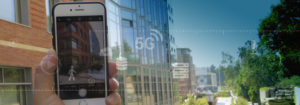UCLA Engineering/Cinema – Augmented Reality: Making it secure, fast, efficient and resilient
 A team of researchers from UCLA and New Mexico State University have received $2 million in funding from the National Science Foundation and Intel to integrate augmented reality into new wireless networks. The project aims to develop augmented reality applications on top of the new NDN network architecture to address the limitations in performance, scalability and availability with today’s TCP/IP architecture.
A team of researchers from UCLA and New Mexico State University have received $2 million in funding from the National Science Foundation and Intel to integrate augmented reality into new wireless networks. The project aims to develop augmented reality applications on top of the new NDN network architecture to address the limitations in performance, scalability and availability with today’s TCP/IP architecture.
“A fully realized AR environment would not be too far from what science fiction movies have depicted, as many of the necessary components are emerging, including both very high speed wireless technologies and advanced applications such as AR, ” said Lixia Zhang, UCLA’s Jon Postel Chair in Computer Science and the lead principal investigator on the project. “However currently, a major bottleneck in the way is the existing network architecture. We want to use this project to showcase how our newly developed NDN architecture can fully utilize the latest wireless technologies to support AR and promote innovative new applications.”
The new project that will explore these challenges is called “ICN-Enabled Secure Edge Networking with Augmented Reality” or ICE-AR. It builds on seven years of research from the NSF-funded Named Data Networking (NDN) project , which is a multi-campus research effort and directed by Zhang. Half of the $2 million in funding will come from grants from National Science Foundation , the other half of funding comes from Intel.
The new project has four research goals:
- Build an operational AR demonstration system, an AR campus browser, on an NDN network that runs over high speed heterogeneous wireless technologies.
- Design robust and resilient networking support for AR that can withstand major network failures.
- Transition the delivery of content to one that utilizes in-network storage and processing, is highly individualized, fast, and efficient.
- Incorporate comprehensive security and privacy throughout the system from the start by utilizing the security building blocks provided by the NDN architecture.
See the full story here: http://engineering.ucla.edu/augmented-reality-making-it-secure-fast-efficient-and-resilient/
Pages
- About Philip Lelyveld
- Mark and Addie Lelyveld Biographies
- Presentations and articles
- Tufts Alumni Bio